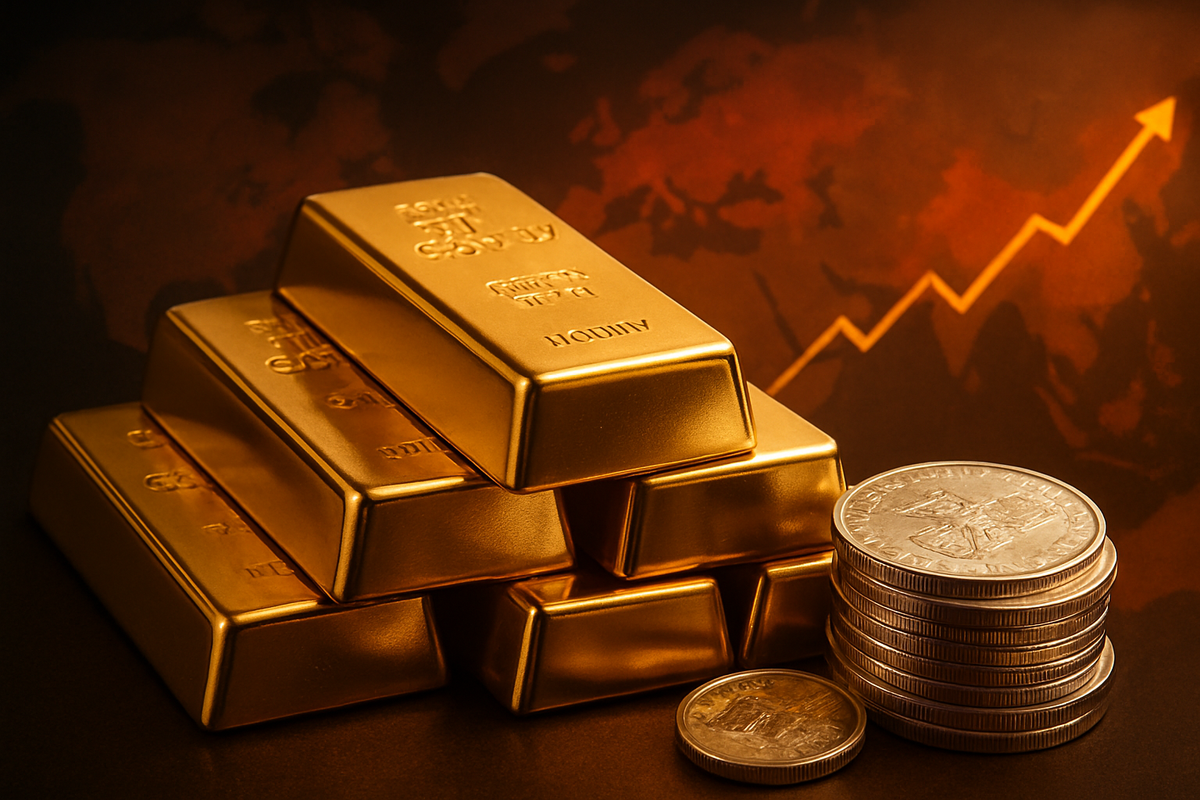
As of November 12, 2025, the global financial markets are witnessing a remarkable and sustained rally in the prices of both gold and silver. This surge is not merely a fleeting market anomaly but a profound reflection of deep-seated investor anxieties, driven by a complex interplay of escalating geopolitical tensions, persistent inflation fears, and a significant shift in global monetary policy expectations. Both precious metals have solidified their roles as indispensable safe-haven assets, attracting substantial capital as investors seek refuge from the turbulence impacting conventional equity and bond markets.
The immediate implications of this rally are widespread, prompting a significant re-evaluation of portfolio strategies across the board. Investors are increasingly diversifying their holdings, enhancing exposure to gold and silver as reliable stores of value and potent hedges against systemic risks and currency debasement. This renewed interest is also providing a substantial boost to the mining sector, with companies experiencing bolstered confidence and renewed impetus for production expansion. The unique phenomenon of precious metals rallying simultaneously with equity markets, such as the Dow Jones Industrial Average surpassing 48,000 points, suggests a market hedging its bets, indicative of underlying anxieties despite outward optimism.
Unpacking the Drivers: A Timeline of Turbulence and Transition
The current gold and silver rally is the culmination of several years of mounting pressures and strategic shifts, with a clear timeline of events leading to the unprecedented price levels seen in late 2025. Gold has surged by approximately 57% year-to-date in 2025, reaching an all-time high of nearly $4,400 per ounce in October before entering a consolidation phase around $4,105-$4,138. Silver has demonstrated an even more impressive performance, with a year-on-year increase exceeding 61%, touching a record high of $54.50 per ounce in October and currently trading around $52-$53.
The genesis of this rally can be traced back to persistent inflationary pressures and escalating geopolitical instability from 2023 onwards. Global headline inflation, while declining from 2022, remained stubbornly high through 2023 and 2024, staying above pre-pandemic averages in a significant number of countries even by early 2025. This "sticky" inflation, coupled with concerns over rising energy and food prices, has continuously eroded the purchasing power of fiat currencies, pushing investors towards tangible assets. Simultaneously, ongoing international conflicts, particularly in Eastern Europe and the Middle East, along with trade disputes and political uncertainties, have consistently fueled safe-haven demand.
A pivotal shift in monetary policy began in September 2024 when the US Federal Reserve (Fed) implemented its first interest rate cut in four years, a 50 basis point reduction that immediately catalyzed a rally in precious metals. The Fed resumed its rate-cutting cycle in September 2025, further bolstering expectations for a December 2025 rate cut amidst weakening U.S. economic data, including a softening labor market and declining consumer sentiment. Lower interest rates reduce the opportunity cost of holding non-yielding assets like gold and silver, making them significantly more attractive. Furthermore, the reclassification of physical gold as a Tier 1 high-quality liquid asset under Basel III rules on July 1, 2025, dramatically enhanced its appeal for commercial banks and institutional investors.
Key players and stakeholders have reacted decisively to these market dynamics. Central banks globally have been unprecedented buyers of gold, accumulating over 1,000 tonnes annually from 2022 to 2024, driven by a desire for diversification away from traditional reserve currencies. Institutional investors, including sovereign wealth funds and exchange-traded funds (ETFs) like SPDR Gold Shares (NYSEARCA: GLD) and iShares Silver Trust (NYSEARCA: SLV), have seen substantial inflows. Mining companies are expanding operations, while financial analysts from institutions like J.P. Morgan and Goldman Sachs are issuing increasingly bullish forecasts, with some predicting gold could reach $5,000/oz by 2026 and silver $65/oz, reflecting strong confidence in the metals' long-term trajectory.
Corporate Fortunes: Winners and Losers in the Precious Metals Boom
The sustained rally in gold and silver prices has created a clear dichotomy in corporate fortunes, significantly benefiting companies involved in precious metals production and streaming, while posing challenges for industrial users and certain segments of the jewelry industry.
Winners: Gold and silver mining companies are experiencing a substantial boost to their revenues and profit margins. Higher commodity prices directly translate into increased cash flows, enabling debt reduction, enhanced shareholder returns, and reinvestment in exploration and development. Major gold producers like Newmont Corporation (NYSE: NEM), Barrick Gold Corporation (NYSE: GOLD), and Agnico Eagle Mines Limited (NYSE: AEM) are reporting strong financial results and seeing their stock prices appreciate. Similarly, silver-focused miners such as Fresnillo PLC (LSE: FRES), the world's largest primary silver producer, and Pan American Silver Corp. (NASDAQ: PAAS) are direct beneficiaries. Precious metals streaming and royalty companies, including Wheaton Precious Metals Corp. (NYSE: WPM) and Franco-Nevada Corporation (NYSE: FNV), also thrive in this environment, as they acquire future production at fixed prices, allowing them to capitalize on rising spot prices without direct operational risks.
Losers: Conversely, companies that rely on gold and silver as key input materials face increased costs, which can squeeze profit margins and necessitate price increases. Industrial users of silver, particularly in the electronics, solar panel, and electric vehicle (EV) manufacturing sectors, are feeling the pinch. Companies like semiconductor giant Advanced Micro Devices, Inc. (NASDAQ: AMD) and solar panel producer Canadian Solar Inc. (NASDAQ: CSIQ) will see their raw material expenses climb, potentially impacting their cost of goods sold. The jewelry industry is also significantly affected. Retailers, especially those specializing in sterling silver pieces like Turquoise Network, face eroded margins due to soaring metal prices and tariffs. Even high-end jewelers may see reduced sales volumes as affordability decreases, prompting some to pivot to alternative metals or emphasize gemstones to mitigate the impact of costly gold and silver.
The rally is thus creating a stark divide, amplifying the profitability for those extracting the metals while forcing those consuming them to implement strategic adjustments, from supply chain optimization to exploring alternative materials or passing on costs to consumers.
Wider Significance: A Paradigm Shift in Global Finance
The gold and silver rally signifies more than just a commodity price surge; it represents a paradigm shift in global financial strategies and reflects deep-seated concerns about the future economic and geopolitical landscape. This event is profoundly impacting broader industry trends, creating ripple effects across various sectors, and influencing regulatory and policy considerations.
One of the most significant broader industry trends is the accelerated re-evaluation of investment portfolios. The sustained rally underscores a growing investor preference for tangible assets as hedges against inflation and currency debasement, leading to increased allocation to precious metals. The unique phenomenon of both safe-haven assets and equity markets rallying simultaneously suggests underlying anxieties that point towards an "everything bubble," where investors are hedging against systemic risks while still participating in growth. This environment also fuels a boom in the mining sector, with junior mining markets experiencing historic capital raising activity, and major players pursuing mergers and acquisitions to consolidate and enhance resilience.
The ripple effects extend to other commodity markets, with a two-tier structure emerging where industrial metals face tariff-related volatility, while precious metals attract defensive flows. Silver's designation as a "critical mineral" by the U.S. Geological Survey in 2025 holds significant regulatory implications. This status could lead to increased government support for domestic silver production, strategic stockpiling, and influence trade policies, further cementing its long-term industrial demand and price support. On the monetary policy front, the anticipated interest rate cuts by the Federal Reserve highlight the ongoing challenge central banks face in balancing inflation management with economic growth, with any deviation potentially intensifying the appeal of precious metals.
Historically, this rally draws parallels to significant periods of precious metal appreciation. The 1970s saw gold surge by 2,300% due to monetary instability, and today's rally shares similar drivers, including fiscal deficits, currency concerns, and geopolitical risks, marking the strongest annual gain since that era. The 2001-2011 bull market, characterized by dollar weakness and financial crises, also provides a comparison. However, a distinguishing factor of the current rally is the unprecedented and consistent level of central bank gold buying since 2022, a structural change that provides a robust floor for prices and signals a long-term commitment to gold as a reserve asset.
What Comes Next: Navigating a Volatile Yet Promising Future
The future trajectory of gold and silver prices, while subject to short-term volatility, is widely anticipated to remain bullish for both the short and long term, driven by the persistent underlying factors. Investors and market participants will need to adopt agile strategies to navigate emerging opportunities and challenges.
In the short term (late 2025 - early 2026), gold is expected to consolidate near its current elevated levels, with potential for further gains towards the $4,100-$4,200 range. Silver is also projected to maintain its dynamism, potentially pushing towards $51-$52 per ounce. However, periods of consolidation and potential pullbacks should be anticipated, which analysts often view as healthy market digestion and buying opportunities. Long-term (2026-2030) forecasts are even more optimistic. Major institutions like J.P. Morgan and Goldman Sachs project gold prices to reach $4,000-$5,000 per ounce by mid-2026, with some aggressive forecasts eyeing $5,000+ by 2026 and significantly higher by 2030. Silver is also expected to see substantial growth, with targets ranging from $59 to $100 per ounce by 2026, and potentially $160-$180 by 2030, supported by its dual role as a monetary and industrial metal.
Potential strategic pivots for investors include maintaining a diversified portfolio that balances gold for stability with silver for industrial growth and leverage. A "buy on dips" strategy is frequently recommended to capitalize on price pullbacks. Furthermore, the rise of tokenized Real World Assets (RWAs) offers new avenues for efficient, tax-aware rebalancing. Challenges include managing commodity price volatility, the potential for a resurgence in U.S. dollar strength, or a more hawkish-than-expected Federal Reserve stance if inflation proves more persistent. Any rapid de-escalation of geopolitical tensions or a significant reduction in central bank buying could also create headwinds.
Potential scenarios range from a sustained bullish rally (the base case, driven by persistent safe-haven demand, central bank buying, and accommodative monetary policies) to moderate growth with consolidation (a healthy pause before further appreciation). A temporary correction/pullback due to external factors is also a possibility, which long-term investors would likely view as a buying opportunity. In the event of an extreme global economic downturn or an unprecedented geopolitical crisis, an extreme bullish / "black swan" event scenario could see precious metals experience an accelerated rally, reflecting a profound loss of confidence in traditional financial systems.
Wrap-Up: A Resilient Future for Precious Metals
The gold and silver rally of 2025 stands as a definitive marker of a turbulent yet transformative period in global finance. Its key takeaways underscore the enduring resilience and indispensable role of precious metals as a bedrock for investment portfolios in an era defined by uncertainty.
The significant price appreciation, driven by anticipated Federal Reserve rate cuts, weakening U.S. economic data, persistent geopolitical tensions, and robust central bank demand, collectively paints a picture of a market structurally shifting towards tangible assets. Silver, with its dual appeal as both a monetary and critical industrial metal, particularly benefiting from the green energy transition, is poised for potentially outsized gains. This rally is not merely a cyclical event but reflects a fundamental recalibration of risk and value perception globally.
Moving forward, the market is expected to remain largely bullish for both gold and silver, with institutional forecasts projecting continued appreciation into 2026 and beyond. While short-term volatility and consolidation phases are anticipated, the overarching sentiment points to sustained demand, supported by the ongoing "debasement trade" where investors favor hard assets over fiat currencies. The lasting impact of this rally will likely be a reinforced perception of gold and silver as core portfolio assets, essential for diversification and hedging against systemic risks, rather than solely speculative plays.
Investors should closely watch several critical indicators in the coming months: the Federal Reserve's monetary policy decisions, particularly the timing and magnitude of interest rate cuts; ongoing U.S. economic data, including inflation trends and labor market health; any developments in global geopolitical conflicts; the strength of the U.S. Dollar; and, crucially, continued central bank buying trends for gold. For silver, specific attention should be paid to growth in green technology sectors. Monitoring these factors will be key to navigating the opportunities and challenges in what promises to be a dynamic and potentially highly rewarding period for precious metals investors.
This content is intended for informational purposes only and is not financial advice




